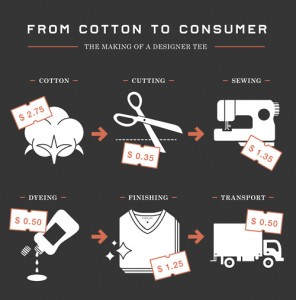
Graphic from retailer Everlane summarizing production costs for t-shirts that retail for fifty dollars.
In a tale of unimaginable sorrow that is made all the worse by the unconscionable greed that brought it about, at least 194 are now known to be dead in the collapse of a building in Bangladesh. But this was not just any building that collapsed, it was a building that housed multiple garment manufacturers. And in a pattern that has been repeated many times before, we see death brought about by the craven actions of the managers of the production companies while US retailers profess grief and claim no direct connection to the particular factories affected. Over time, once attention dies down a bit, those connections will become clear due to what appears to be a system designed to distance the retailers from the sweat shops via multiple subcontracting arrangements.
From today’s New York Times:
Search crews on Thursday clawed through the wreckage of a collapsed building that housed several factories making clothing for European and American consumers, with the death toll rising to at least 194 with many others still unaccounted for.
/snip/
The Bangladeshi news media reported that inspection teams had discovered cracks in the structure of Rana Plaza on Tuesday. Shops and a bank branch on the lower floors immediately closed. But the owners of the garment factories on the upper floors ordered employees to work on Wednesday, despite the safety risks.
Labor activists combed the wreckage on Wednesday afternoon and discovered labels and production records suggesting that the factories were producing garments for major European and American brands. Labels were discovered for the Spanish brand Mango, and for the low-cost British chain Primark.
Activists said the factories also had produced clothing for Walmart, the Dutch retailer C & A, Benetton and Cato Fashions, according to customs records, factory Web sites and documents discovered in the collapsed building.
The drive to save pennies on garments is directly behind this and similar tragedies:
“The front-line responsibility is the government’s, but the real power lies with Western brands and retailers, beginning with the biggest players: Walmart, H & M, Inditex, Gap and others,” said Scott Nova, executive director of Worker Rights Consortium, a labor rights organization. “The price pressure these buyers put on factories undermines any prospect that factories will undertake the costly repairs and renovations that are necessary to make these buildings safe.”
These sorts of tragedies happen with alarming regularity. Last September, at least 258 people died in a fire in a Karachi garment factory that had escaped safety inspections.
And note that although governments are cited in these tragedies for failing to provide adequate regulation and inspections, it is the tremendous pressure applied by US retailers to reduce production costs that drives many of the decisions that put workers at risk of death.
But these retailers are chasing very tiny cost reductions in the overall retail prices of garments. The graphic above is taken from a Tumblr post by retailer Everlane (they are touting their own business model of removing wholesalers, so they do have a particular point of view in promulgating the numbers). In this version of the industry, we see $1.35 going to the workers who sew a shirt and thirty five cents to the worker who cuts the fabric. The overall direct costs in this case come to $6.70. The second half of the graphic in the Tumblr post shows that the the t-shirt is then sold to a wholesaler for $15 and the retailer then sells to a consumer for $50.
At least when it comes to designer t-shirts retailing for $50 (okay, that leaves out WalMart but from these stories it looks as though at least some high end retailers and the low price retailers share many of the same garment factories) the wages paid to garment workers are only a few percent of the overall retail price. And yet the companies apply huge pressure to the owners of the garment factories because John Galt tells them that the “job creators” at these name-brand labels deserve huge profits while governments must stay out of the way of the engines of wealth.
The concept of the fifty dollar designer t-shirt is getting some popular culture push-back. From the lyrics of “Thrift Shop”, by Macklemore and Ryan Lewis:
I hit the party and they stop in that motherfucker
They be like “Oh that Gucci, that’s hella tight”
I’m like “Yo, that’s fifty dollars for a t-shirt”
Limited edition, let’s do some simple addition
Fifty dollars for a t-shirt, that’s just some ignorant bitch shit
I call that getting swindled and pimped, shit
I call that getting tricked by business
That shirt’s hella dough
And having the same one as six other people in this club is a hella don’t
Peep game, come take a look through my telescope
Trying to get girls from a brand?
Man you hella won’t, man you hella won’t
Rejecting artificial demand created by a name brand label that exploits low wage garment workers would be wonderful first step toward improving the situation. However, this move needs to be followed by actively embracing the concept of living wages and safe working conditions if the evils of the current situation are to be addressed fully.
And, well, because it’s fucking awesome:
[youtuber youtube=’http://www.youtube.com/watch?v=QK8mJJJvaes’]